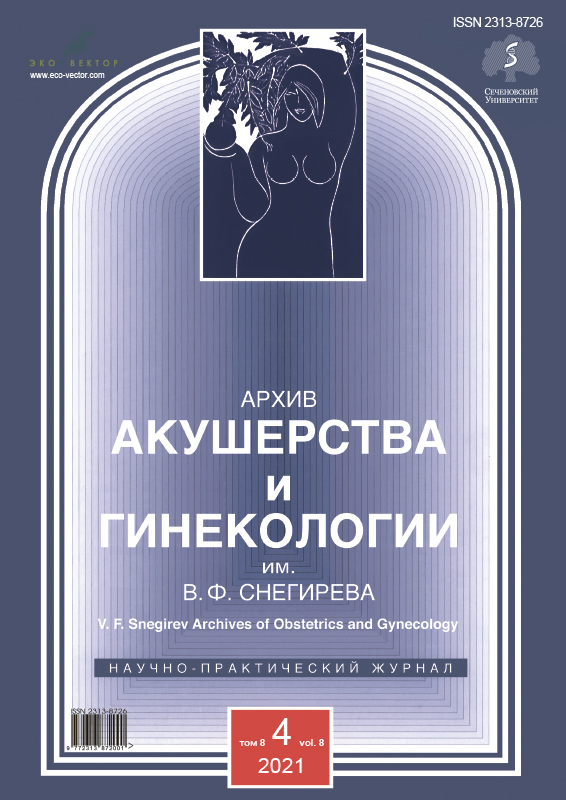Течение беременности и родов у коморбидных пациенток с гестационным сахарным диабетом
- Авторы: Жаркин Н.А.1, Заболотнева К.О.1
-
Учреждения:
- Волгоградский государственный медицинский университет
- Выпуск: Том 8, № 4 (2021)
- Страницы: 213-219
- Раздел: Оригинальные исследования
- Статья получена: 09.12.2021
- Статья одобрена: 09.12.2021
- Статья опубликована: 15.12.2021
- URL: https://archivog.com/2313-8726/article/view/89983
- DOI: https://doi.org/10.17816/2313-8726-2021-8-4-213-219
- ID: 89983
Цитировать
Полный текст
Аннотация
Цель исследования ― оценка течения беременности и родов у коморбидных пациенток с гестационным сахарным диабетом (ГСД).
Материалы и методы. Выполнен ретроспективный анализ 168 индивидуальных карт беременных и родильниц с ГСД за 2018–2020 гг. Основным критерием включения в анализ было наличие подтверждённого ГСД.
Результаты. Анализ коморбидного фона беременных показал наличие избыточной массы тела и ожирения у 48,2% пациенток, что позволило отнести данное состояние к определяющим в развитии ГСД. В 58,7% случаев родоразрешение выполняли путём кесарева сечения, при этом у 11,3% беременных хирургическое родоразрешение произведено впервые, основным показанием для него был крупный плод.
Заключение. Коморбидный фон у беременных способствует формированию ГСД, который обусловливает высокий процент акушерских осложнений и диабетической фетопатии. Стратегия риска при данной патологии ― прогнозирование осложнений при помощи непрерывного амбулаторного наблюдения, своевременного лечения и госпитализации в соответствии со степенью риска.
Ключевые слова
Полный текст
Об авторах
Николай Александрович Жаркин
Волгоградский государственный медицинский университет
Автор, ответственный за переписку.
Email: zharkin55@mail.ru
ORCID iD: 0000-0002-8094-0427
Scopus Author ID: 6602293084
ResearcherId: B-2794-2017
д.м.н., профессор, зав. кафедрой акушерства и гинекологии
Россия, 400131, ВолгоградКсения Олеговна Заболотнева
Волгоградский государственный медицинский университет
Email: kselofon@yandex.ru
ORCID iD: 0000-0002-7802-469X
к.м.н., доцент
Россия, 400131, ВолгоградСписок литературы
- Акушерство. Национальное руководство / под ред. Г.М. Савельевой, Г.Т. Сухих, В.Н. Серова, В.Е. Радзинского. 2-е изд. Москва: ГЭОТАР-Медиа, 2019. 1080 с.
- Российская ассоциация эндокринологов, Российское общество акушеров-гинекологов. Гестационный сахарный диабет. Диагностика, лечение, акушерская тактика, послеродовое наблюдение. Клинические рекомендации. 2020. 53 с.
- Дедов И.И., Краснопольский В.И., Сухих Г.Т., от имени рабочей группы. Российский национальный консенсус «Гестационный сахарный диабет: диагностика, лечение, послеродовое наблюдение» // Сахарный диабет. 2012. № 4. С. 4–10.
- International Diabetes Federation. Diabetes. Atlas. 9th edition. Brussels, Belgium : International Diabetes Federation, 2019.
- Гвоздев А.А., Королькова А.А. Факторы развития и прогнозирования гестационного сахарного диабета // Вестник Российского государственного медицинского университета. 2014. № 2. С. 8.
- Scholtens D.M., Kuang A., Lowe L.P., et al.; HAPO Follow-Up Study Cooperative Research Group. Hyperglycemia and adverse pregnancy outcome follow-up study (HAPO FUS): maternal gestational diabetes mellitus and childhood glucose metabolism // Diabetes Care. 2019. Vol. 42, N 3. P. 381–392. doi: 10.2337/dc18-2021
- HAPO Study Cooperative Research Group; Metzger B.E., Lowe L.P., Dyer A.R., et al. Hyperglycemia and adverse pregnancy outcomes // N Engl J Med. 2008. Vol. 358, N 19. P. 1991–2002. doi: 10.1056/NEJMoa0707943
- Себко Т.В., Доброхотова Ю.Э., Иванова Т.А., и др. Генетические маркеры инсулинорезистентности при гестационном сахарном диабете // Сахарный диабет. 2009. № 4. С. 38–41.
- Демидова Т.Ю., Ушанова Ф.О. Патофизиологические аспекты развития гестационного сахарного диабета // Русский медицинский журнал. Медицинское обозрение. 2019. Т. 3, № 10-2. С. 86–91.
- Zhang C., Bao W., Rong Y., et al. Genetic variants and the risk of gestational diabetes mellitus: a systematic review // Hum Reprod Update. 2013. Vol. 19, N 4. Р. 376–390. doi: 10.1093/humupd/dmt013
- Лысенко С.Н., Чечнева М.А., Петрухин В.А., Бурумкулова Ф.Ф. Ультразвуковая диагностика диабетической фетопатии // Доктор.Ру. 2019. № 7 (162). С. 19–23. doi: 10.31550/1727-2378-2019-162-7-19-23
- Chen D., Xia G., Xu P., Dong M. Peripartum serum leptin and soluble leptin receptor levels in women with gestational diabetes // Acta Obstet Gynecol Scand. 2010. № 89. P. 1595–1599. doi: 10.3109/00016349.2010.514040
Дополнительные файлы












